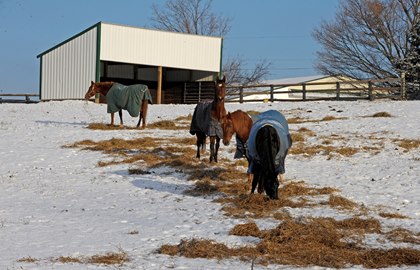
By By James Little, DVM
From the great website TheHorse.com
QUESTION: How does feeding a large amount of good quality hay to a group of 15 or fewer horses on winter pasture covered in snow at two or more day intervals affect their digestion and health? DANA SZEGEDY, OAKLEY, UTAH
ANSWER: Feeding large amounts of hay to a group of horses is done quite often by the use of large round bales and likely by other means. I believe horse owners and managers can successfully feed horses this way if they take appropriate steps and understand potential risks.
First, sufficient amount of hay should be fed to ensure access to hay over the entire period. In other words, don’t feed an amount that will be consumed in one day and leave the horses without hay for the rest of the interval between feedings. If gaps between feedings exist, it could make the horses more prone to things such as gastric ulcers, digestive upset, inadequate calorie intake, and cold intolerance.
Exposure of the hay to the elements might affect the quality of the hay. Over time, sunlight exposure can lead to a decrease in hay vitamin content, but exposure over only a couple of days shouldn’t have a dramatic effect.
The hay would also be potentially exposed to moisture from precipitation and from the ground. Increased moisture can lead to decay and mold development, which would have potential for causing problems. This could be especially problematic if the horses do not eat some of the hay and it is left exposed to the elements for a longer period of time and then eaten when better quality forage is not available to them. This scenario could also lead to decay, development of an anaerobic environment, and propagation of botulism-causing organisms if they are present.
If the hay is being fed scattered on the ground (such as when we throw a few flakes out in individual piles, as opposed to in a bale format), the horses would also affect the quality of the hay by stepping, lying, and urinating/defecating on it.
Feeding multiple horses can be a challenge, as well, because individual horses have different nutritional requirements. Also, some horses are more aggressive than others, leading to those animals consuming the majority of available forage. In these situations, young or old animals, and horses with metabolic syndrome or dental issues, might not get enough hay.
To ensure you know the starting quality of your hay, I recommend having your hay analyzed to determine its true nutritional value. Sometimes hay that looks perfect can have lower than expected nutritional values, and vice versa.
It is important to feed the appropriate quality and amount of hay for the type of horse you have. “Easy keeper” horses (those that require less feed to maintain a healthy body condition) might not need the same hay as the “hard keepers” (horses that require more feed). However, in winter it’s important to provide adequate amounts of roughage to all horses. Throughout the year it is important to keep an eye on each horse’s body condition score, know their health status, and adjust their management as needed.
Your personal equine veterinarian should be your source of information when it comes to your horses’ health and should partner in developing a management plan that is practical for you and takes into consideration your herd’s nutrition, health, and overall well being.
